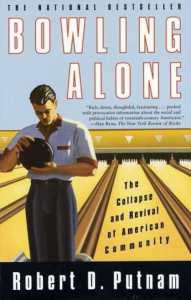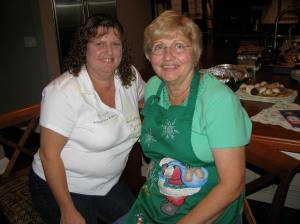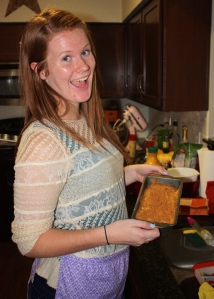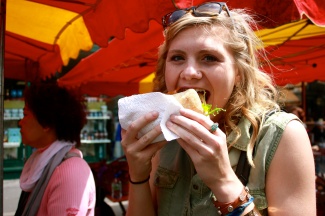 Food is necessary not only for sustainable purposes, but for identity, culture, tradition, and sociological being. Eating is an everyday act that most take for granted. It connects individuals across the globe through agricultural workers, trade, commercial concerns, weather patterns, financial markets, transport networks, local cultural geography, changing social trends, and the impending crises hitting our current food system. It is one of our most natural acts that impacts not only our survival, but the planet’s survival as well. Sitting down for a casual family dinner, one is oblivious to the global ramifications one meal can have. The meat may have come locally or regionally, but everything including spices, fruits, vegetables, olive oil, rice, and juice are sourced from China to Chile to India to Argentina. Our modern food system has evolved from agricultural communities growing, harvesting, and preparing meals together on a social level to simply paying for byproducts pumped with chemicals. This disconnect from our food’s source has paved way for rising prices, on-going climate change, increasing fuel costs, flaws of the global market, worldwide pesticide pollution, pest adaption and resistance, loss of soil fertility and organic carbon, soil erosion, decreasing biodiversity, desertification, starvation, and obesity.
Food is necessary not only for sustainable purposes, but for identity, culture, tradition, and sociological being. Eating is an everyday act that most take for granted. It connects individuals across the globe through agricultural workers, trade, commercial concerns, weather patterns, financial markets, transport networks, local cultural geography, changing social trends, and the impending crises hitting our current food system. It is one of our most natural acts that impacts not only our survival, but the planet’s survival as well. Sitting down for a casual family dinner, one is oblivious to the global ramifications one meal can have. The meat may have come locally or regionally, but everything including spices, fruits, vegetables, olive oil, rice, and juice are sourced from China to Chile to India to Argentina. Our modern food system has evolved from agricultural communities growing, harvesting, and preparing meals together on a social level to simply paying for byproducts pumped with chemicals. This disconnect from our food’s source has paved way for rising prices, on-going climate change, increasing fuel costs, flaws of the global market, worldwide pesticide pollution, pest adaption and resistance, loss of soil fertility and organic carbon, soil erosion, decreasing biodiversity, desertification, starvation, and obesity.
The geography of food is a field of human geography, which focuses on patterns of food production and consumption on the local and global scale. Through this field, researchers look to uncover and understand unequal relationships between developed and developing countries in relation to innovation, production, transportation, retail, and consumption of food. A key aspect of this is interdependence as everyone is connected in the world’s food system whether that is based on its production, transportation, or trade. InBowling Alone, Robert Putnam describes how Americans have become increasingly disconnected from one another and social structures have disintegrated. This fundamental human nature has a profound affect on the health, safety, and happiness of our society. Our quick, convenient, cheap culture is centered on the idea of food for fuel rather than something of moral and social significance. Food cultures that once treated cooking and eating as central elements in maintaining social structure and tradition are becoming overcome by cultures dominated by cost and convenience of food. Social meals are a thing of the past and cooking is merely an act seen on television and defined by the books garnishing our coffee tables.
In addition, globally the production of food is unequal and unstable. There are two components involved in the sustenance of food that are distributed irregularly: environmental capacity of the area and human capacity. Environmental capacity is defined as the ability to accommodate a particular activity or rate of an activity without unacceptable impact. This is where climate, soil type, and water availability come into place. Human capacity in relation to food production is defined as the size of the population and the amount of agricultural skill within that population. Partnered with financial capital, these two need to be at ideal levels in order for the food system to support the Green Revolution and adequately meet the world’s demand.
The very methods that eliminated starvation and increased the abundance of food across the globe, such as large-scale livestock operations and chemically intensive farming, have degraded the productive capacities of our natural systems to the point that it is unclear how we will feed the nearly ten billion people expected by midcentury or even how long current food production will last. Currently, Canada, USA, and Europe consume the most calories with an average per capita consumption per day of around 3400. Studies focused on consumption patterns in these areas lay the blame on increased caloric intake on soft drink and fast food consumption, and decreased physical activity. Given this information, even if people became smarter at finding more ways to make food, hunger is unavoidable for certain groups because any increase in food served only serves to make populations larger.
For the following few months, I will feature a new blog series to supplement my latest restaurant reviews and cooking endeavors called “Food is…” Each post will detail a different aspect that our food system should be versus what it currently is. I will use academic research along with popular books including The End of Food, McDonaldization, Food Inc., The American Way of Eating, The Omnivore’s Dilemma, and Food Rules. Coming off my experience from London, I want to compare America’s current food system versus the European food system, how both are unique in their own ways, and how we can build upon each.
Food defines us. We literally are what we eat in regards to values, ethics, character, integrity, and so on. The food market is a product of billions of food decisions. Each individual needs to realize their important role in the food system, so that we may all work together to correct its flaws.
So what are you then…A dirty McDonald’s big mac with a large fry, a refined dish of gnocchi and grilled asparagus from the best italian restaurant in the city, or a home cooked meal of meal of spaghetti squash and tossed spinach salad? Each decision impacts our environment, culture, and society, so choose wisely.




































